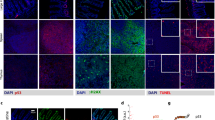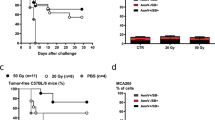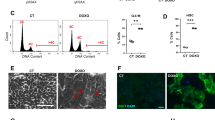Abstract
The tumor suppressor protein, p53, plays a critical role as a transcriptional activator of downstream target genes involved in the cellular response to DNA damaging agents. We examined the cell cycle checkpoint response of human mammary epithelial cells (HMEC) and their isogenic fibroblast counterparts to ionizing (IR) and ultraviolet (UV) radiation, two genotoxic agents whose DNA damage response pathways involve p53. Using flow cytometric analysis, we found that both mortal and immortalized HMEC, which contain wild-type p53 sequence, do not exhibit a G1 arrest in response to IR, but show an intact G2 checkpoint. Supportive evidence from Western analyses revealed that there was neither an increase in p53 nor one of its downstream targets, p21WAF1, in HMEC exposed to IR. In contrast, isogenic mammary fibroblasts arrest at the G1 checkpoint and induce the p53 and p21WAF1 proteins following IR. By comparison, HMEC exposed to UV displayed an S phase arrest and induced the expression of p53 and p21WAF1. Our results show that the cellular response to DNA damage depends on both the type of damage introduced into the DNA and the specific cell type.
This is a preview of subscription content, access via your institution
Access options
Subscribe to this journal
Receive 50 print issues and online access
$259.00 per year
only $5.18 per issue
Buy this article
- Purchase on Springer Link
- Instant access to full article PDF
Prices may be subject to local taxes which are calculated during checkout







Similar content being viewed by others
References
Banin S, Moyal L, Shieh S-Y, Taya T, Anderson CW, Chessa L, Smorodinsky NI, Prives C, Reiss Y, Shiloh Y and Ziv Y. . 1998 Science 281: 1674–1677.
Buchman VL, Chumakov PM, Ninkina NN, Samarina OP and Georgiev GP. . 1988 Gene 70: 245–252.
Canman CE, Lim D-S, Cimprich KA, Taya Y, Tamai K, Sakaguchi K, Appella E, Kastan MB and Siliciano JD. . 1998 Science 281: 1677–1679.
Canman CE, Wolff AC, Chen Jr C-Y, Fornace AJ and Kastan MB. . 1994 Cancer Res. 54: 5054–5058.
Chowdary DR, Dermody JJ, Jha KK and Ozer HL. . 1994 Mol. Cell. Biol. 14: 1997–2003.
Cistulli CA and Kaufmann WK. . 1998 Cancer Res. 58: 1993–2002.
Delmolino L, Band H and Band V. . 1993 Carcinogenesis 14: 827–832.
Fiscella M, Ullrich SJ, Zambrano N, Shields MT, Lin D, Lees-Miller SP, Anderson CW, Mercer WE and Appella E. . 1993 Oncogene 8: 1519–1528.
Ford JM, Baron EL and Hanawalt PC. . 1998 Cancer Res. 58: 599–603.
Ford JM and Hanawalt PC. . 1995 Proc. Natl. Acad. Sci. USA 92: 8876–8880.
Gadbois DM and Lehnert BE. . 1997 Cancer Res. 57: 3174–3179.
Girinsky T, Koumenis C, Graeber TG, Peehl DM and Giaccia AJ. . 1995 Cancer Res. 55: 3726–3731.
Graeber TG, Peterson JF, Mitchell T, Monica Jr K, Fornace AJ and Giaccia AJ. . 1994 Mol. Cell. Biol. 14: 6264–6277.
Haines DS, Landers JE, Engle LJ and George DL. . 1994 Mol. Cell. Biol. 14: 1171–1178.
Hartmann A, Blaszyk H, McGovern RM, Schroeder JJ, Cunningham J, DeVries EMG, Kovach JS and Sommer SS. . 1995 Oncogene 10: 681–688.
Hartwell LH and Kastan MB. . 1994 Science 266: 1821–1828.
Hartwell LH and Weinert TA. . 1989 Science 246: 629–634.
Hupp TR, Meek DW, Midgley CA and Lane DP. . 1992 Cell 71: 875–886.
Kapoor M and Lozano G. . 1998 Proc. Natl. Acad. Sci. USA 95: 2834–2837.
Kastan MB, Onyekwere O, Sidransky D, Vogelstein B and Craig RW. . 1991 Cancer Res. 51: 6304–6311.
Kastan MB, Zhan Q, El-Deiry WS, Carrier F, Tyler J, Walsh WV, Plunkett BS, Vogelstein Jr B and Fornace AJ. . 1992 Cell 71: 587–595.
Kaufmann WK, Levedakou EN, Grady HL, Paules RS and Stein GH. . 1995 Cancer Res. 55: 7–11.
Kaufmann WK and Wilson SJ. . 1994 Mutat. Res. 314: 67–76.
Kuerbitz SJ, Plunkett BS, Walsh WV and Kastan MB. . 1992 Proc. Natl. Acad. Sci. USA 89: 7491–7495.
Leadon SA and Cooper PK. . 1993 Proc. Natl. Acad. Sci. USA 90: 10499–10503.
Lehman TA, Modali R, Boukamp P, Stanek J, Bennett WP, Welsh JA, Metcalf RA, Stampfer MR, Fusenig N, Rogan EM and Harris CC. . 1993 Carcinogenesis 14: 833–839.
Linke SP, Clarkin KC, Leonardo AD, Tsou A and Wahl GM. . 1996 Genes Dev. 10: 934–947.
Ljungman M and Zhang F. . 1996 Oncogene 13: 823–831.
Lu H, Taya Y, Ikeda M and Levine AJ. . 1998 Proc. Natl. Acad. Sci. USA 95: 6399–6402.
Maki CG and Howley PM. . 1997 Mol. Cell. Biol. 17: 355–363.
Maltzman W and Czyzyk L. . 1984 Mol. Cell. Biol. 4: 1689–1694.
Matlashewski GJ, Tuck S, Pim D, Lamb P, Schneider J and Crawford LV. . 1987 Mol. Cell. Biol. 7: 961–963.
McKinnon PJ. . 1987 Hum. Genet. 75: 197–208.
Meyn MS. . 1995 Cancer Res. 55: 5991–6001.
Milne DM, Palmer RH and Meek DW. . 1992 Nuc. Acid. Res. 20: 5565–5570.
Namba H, Hara T, Tukazaki T, Migita M, Ishikawa N, Ito K, Nagataki S and Yamashita S. . 1995 Cancer Res. 55: 2075–2080.
Nelson WG and Kastan MB. . 1994 Mol. Cell. Biol. 14: 1815–1823.
Nigro JM, Aldape KD, Hess SM and Tlsty TD. . 1997 Cancer Res. 57: 3635–3639.
Reich NC, Oren M and Levine AJ. . 1983 Mol. Cell. Biol. 3: 2143–2150.
Rogel A, Popliker M, Webb CG and Oren M. . 1985 Mol. Cell. Biol. 5: 2851–2855.
Siliciano JD, Canman CE, Taya Y, Sakaguchi K, Appella E and Kastan MB. . 1997 Genes Dev. 11: 3471–3481.
Stampfer MR. . 1985 J. Tissue Cult. Methods 9: 107–116.
Stampfer MR and Bartley JC. . 1985 Proc. Natl. Acad. Sci. USA 82: 2394–2398.
Wang XW, Forrester K, Yeh H, Feitelson MA, Gu JR and Harris CC. . 1994 Proc. Natl. Acad. Sci. USA 91: 2230–2234.
Wang XW, Yeh H, Schaeffer L, Roy R, Moncollin V, Egly J-M, Wang Z, Friedberg EC, Evans MK, Taffe BG, Bohr VA, Weeda G, Hoeijmakers JHJ, Forrester K and Harris CC. . 1995 Nature Genet. 10: 188–195.
Wazer DE, Liu X-L, Chu Q, Gao Q and Band V. . 1995 Proc. Natl. Acad. Sci. USA 92: 3687–3691.
White AE, Livanos EM and Tlsty TD. . 1994 Genes Dev. 8: 666–677.
Acknowledgements
We are grateful to Dr William K Kaufmann for enlightening discussions and critical reading of the manuscript. This research was supported by US Public Health Service Grants CA62059 and CA40453 from the National Cancer Institute, and a predoctoral (KMM) and postdoctoral (SMH) traineeship (T32 ES07126) from the National Institute of Environmental Health Sciences.
Author information
Authors and Affiliations
Rights and permissions
About this article
Cite this article
Meyer, K., Hess, S., Tlsty, T. et al. Human mammary epithelial cells exhibit a differential p53-mediated response following exposure to ionizing radiation or UV light. Oncogene 18, 5795–5805 (1999). https://doi.org/10.1038/sj.onc.1202977
Received:
Revised:
Accepted:
Published:
Issue Date:
DOI: https://doi.org/10.1038/sj.onc.1202977
Keywords
This article is cited by
-
Epigenetic and transcriptional determinants of the human breast
Nature Communications (2015)
-
Gene expression pattern of insect fat body cells from in vitro challenge to cell line establishment
In Vitro Cellular & Developmental Biology - Animal (2014)
-
FISH-based analysis of 10- and 25-kV soft X-ray–induced DNA damage in 184A1 human mammary epithelial cells
Radiation and Environmental Biophysics (2012)
-
The p53/p21 DNA damage-signaling pathway is defective in most meningioma cells
Journal of Neuro-Oncology (2007)
-
Cell death in irradiated prostate epithelial cells: role of apoptotic and clonogenic cell kill
Prostate Cancer and Prostatic Diseases (2003)



